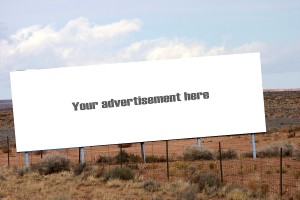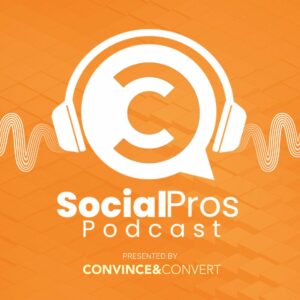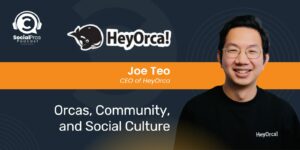Hosted By
About Social Pros Podcast:
Social Pros is one of the longest-running marketing podcasts in existence (10 YEARS and counting), and was recently recognized as the #1 Audio/Podcast Series by the Content Marketing Awards.
Our purpose? Making sure that we speak to real people doing real work in social media.
Listeners get inside stories and behind-the-scenes secrets about how teams at companies like Google, Reddit, Glossier, Zillow, Lyft, Marvel, and dozens more, staff, operate, and measure their social media programs. With 600+ episodes, the Social Pros Podcast brings the humanity of social media to the forefront, while providing incredibly useful marketing strategies that listeners can immediately implement.
Follow Social Pros on LinkedIn.
To inquire about becoming a guest or show sponsor, please email our Executive Producer, Leanna Pham, at leanna@convinceandconvert.com.
Apple Podcast Reviews:
The Social Pros podcast has quickly become a favorite in my feed! I'm consistently impressed by the engaging conversations, insightful content, and actionable ideas. I truly learn something every time I listen!
@Arlie KThis is absolutely an awesome listen for anyone in communications or social media!!
@Will31CThis podcast has become one of my staple weekly podcasts for learning about marketing! Love the conversations that they have and it's always enjoyable and educational!
@Simonstone95Love the podcast - informative, in depth and spot on for any business size.
@MissTriathlon
This is Episode 27 of the Social Pros Podcast : Real People Doing Real Work in Social Media. This episode features Jeremiah Owyang and Rebecca Lieb from the Altimeter Group. Read on for insights from Jay Baer plus Eric Boggs’s Social Media Stat of the Week (This week: 76% of CMOs think that social has a measurable impact on sales and social data impacts decisions for 89% of CMOs.)
 This is Episode 27 of the Social Pros Podcast : Real People Doing Real Work in Social Media. This episode features Jeremiah Owyang and Rebecca Lieb from the Altimeter Group. Read on for insights from Jay Baer plus Eric Boggs‘s Social Media Stat of the Week (This week: 76% of CMOs think that social has a measurable impact on sales and social data impacts decisions for 89% of CMOs.)
This is Episode 27 of the Social Pros Podcast : Real People Doing Real Work in Social Media. This episode features Jeremiah Owyang and Rebecca Lieb from the Altimeter Group. Read on for insights from Jay Baer plus Eric Boggs‘s Social Media Stat of the Week (This week: 76% of CMOs think that social has a measurable impact on sales and social data impacts decisions for 89% of CMOs.)
Listen Now
Click the play button to listen here:
[podcast]http://socialpros.podbean.com/mf/web/u8sdt/SocialProsEpisode27.mp3[/podcast]
Download the audio file:
http://socialpros.podbean.com/mf/web/u8sdt/SocialProsEpisode27.mp3
The RSS feed is: http://feeds.feedburner.com/socialprospodcast
Find us on iTunes: http://itunes.apple.com/us/podcast/convince-convert-blog-social/id499844469
Please Support Our Sponsors
Huge thanks to data-driven social media management software company Argyle Social for their presenting sponsorship, as well as Infusionsoft, Janrain, and Jim Kukral at DigitalBookLaunch. We use Argyle Social for our social engagement; we use Infusionsoft for our email; Janrain is our crackerjack social integration company, and Jim is our guest host for the podcast (and a smart guy).
Social Pros Transcript For Your Reading Enjoyment, Thanks to Speechpad for the Transcription
![]()
Jay: Hey everybody, we are back with episode number 27, two seven, of Social Pros. I am Jay Baer from Convince & Convert, joined as always by my pal, CEO of data-driven social media marketing software company Argyle Social, Mr. Eric Boggs.
Eric: Hello, Jay. These introductions are beginning to sound more and more like “I’m your excellent host Wayne Campbell and with me, as always is Garth.” That’s kind of cool.
Jay: You like that? I’m going to start dressing like that during these shows. You are in lovely Durham, North Carolina, any UNC grads on the U.S. basketball team?
Eric: No, there’s not actually.
Jay: That seems amazing to me. That usually you would be stocked in that regard.
Eric: Yeah, we usually are. I think Vince Carter may have been the last UNC Olympian. There are quite a few Tarheels on the Olympic teams, though. I know there are a couple women on the field hockey team. There are probably several women on the soccer team.
Jay: Their basketball team is something else. When Kevin Love is your 11th man, you’re a pretty good basketball team.
Eric: I know it. I read an overly detailed article on grantland.com about, if you were choosing the all-time dream team from the 1992 official dream team and this year’s team, basically Patrick Ewing and Chris Paul were the last two cut. Pretty fascinating position breakdown of all the players across the two teams, it was way nerdy to read for a basketball fan.
Jay: Well, just about anything published on grantland.com is about my favorite thing ever. I get the quarterly digest book and the whole thing. My favorite is the “Breaking Bad” weekly recaps. That’s my favorite show.
Eric: Oh God, yeah. We should start another podcast to talk about that.
Jay: A “Breaking Bad” fan podcast? I like that. Because you know what you and I have, is a ton of time on our hands? I think that’s exactly how we should…
Eric: Yeah, I know. Well, it’s basically just less sleep which…
Jay: Yeah, that’s true.
Eric: …fine, whatever.
Jay: Hey, you have young children anyway.
Eric: Yeah.
Jay: Let’s thank our sponsors, Eric’s company Argyle Social. Also our good friends at Infusionsoft, email and CRM folks that we use for all of our email stuff at Convince & Convert and at Social Pros. Our friends at Janrain, all kinds of interesting social signing and social media database marketing. They’re fantastic folks out of Portland. And our buddy Jim Kukral at digitalbooklaunch.com, who in addition to helping authors get their books published digitally is our erstwhile co-host and fill-in guy here on Social Pros.
Eric: Indeed. Good old Mr. Kukral, haven’t talked to him in a while.
Jay: I’m sure I’ll be on a trip somewhere and he’ll be on the podcast at some point. We have, speaking of the podcast, an amazing, amazing show today. Not only is the caliber of our guests, but this the first time we’ve ever had the dual guest scenario.


There is not one, but two, guests today on Social Pros, Mr. Jeremiah Owyang and Ms. Rebecca Leib, both from noteworthy, social media and content analyst organization, Altimeter Group, who put together some very fascinating research recently. We’re going to talk to them about that in just a minute.
Jay’s Thought of the Week
Let me tell you this, though. Let me break it down for you, Eric. Here’s my thought of the week here on the social media world. I’m going to write a blog post about this for next week. I think we are confusing marketing and customer service.

I’ve been reading blog posts intermittently, and I think this started with the whole Peter Shankman, “bring me a steak at the airport” deal not too long ago, which we’ll link up. You remember that whole scenario, where Peter was at JFK, as I recall and said, “Geez, Morton’s, I sure wish you would bring me a steak.” They actually brought him a steak and he talked about it and it drove a lot of awareness of them, etc.
Then you started to see these blog posts occur like, “Wow, that’s really great customer service.” I saw another one recently about Doubletree Hotels, who did something out of the ordinary to delight a kid in a hotel, and KLM Airlines has done this. You see every once in a while these kind of above and beyond stories.
But here’s the thing. That’s not customer service. Pulling individual opportunities and circumstantial scenarios from amongst the sea of people complaining about trivia and little tiny things, and making a big deal about it, and earning media coverage based on a one-time deal, is not customer service. It’s marketing wearing a customer service Trojan horse costume.
If you can’t replicate it, if it’s not scalable, if it’s not doable by front line employees who, you’re making $9 an hour, it’s not customer service. It is something else entirely, and I think confusing those two things does us all a disservice.
Eric: Well said. It also sets a weird standard of what you should be doing as a marketer or a customer service person, because it’s kind of setting this weird precedent of a grand gesture that, you’re correct, does not scale and is not sort of the normal day- to-day that people quite frankly want or expect.
Jay: I’m okay with grand gestures. I’m Captain Grand Gestures. I don’t have an issue with the notion. I have an issue of those being passed off as something you should A), expect, and B), is going to happen again and again.
I literally have seen a blog post recently that said this is a triumph of customer service. It’s like no. It’s a triumph of public relations, which doesn’t make it less of a triumph. It’s just a different triumph entirely.
Eric: Where do you think that comes from? We can use Peter Shankman’s example.
Jay: He didn’t say that. Peter didn’t say that this is customer service. But other people said that.
Eric: No, no, no, but his steak story is one that stands out, that a lot of people know of. I wonder if it was someone in customer service that said, “Hey, look. This guy Peter seems really important. We should go out of the way to be really nice to him.” Or if it was some community manager that said, “Oh, holy crap, Peter Shankman just tweeted us,” or, if it was someone in marketing or PR that happened to latch on the opportunity.
You just kind of wonder, what’s the genesis of these kind of over the top service/marketing gestures?
Jay: I think people who have not worked in enterprise sometimes believe that anything that has to do with the customer is inherently customer service.
Eric: Yeah.
Jay: I really do. Maybe that sounds draconian or overly broad, but I really believe that is part of the problem, here.
So, we’re going to replicate that or rectify that. Or we’re going to do something that starts with R. I’m going to write a blog post for next week. Tune in for that.
Eric: Sounds good to me. I will comment in agreement.
Jay: Thank you. You should RSS feed that. Yes, I will actually tweet that out using your platform. Before that happens, do you have a social media stat of the week?
Eric’s Social Media Stat of the Week: 76% of CMOs Say Social Media Has a Measurable Impact on Sales
Eric: I do, I do. I would like to maybe shed some light into the inner workings here at Social Pros.
Jay: Uh-oh.
Eric: This stat of the week came by way of Ian Greenleigh of Bazaarvoice, who basically emailed Jay saying, “Hey, check out this data. You might want to talk about it in your podcast.” So, if you, dear listener, have an idea for social media stat of the week, email it to me or email it to Jay. We like it when people do our homework for us.
 Thank you, Ian, for the great suggestion. Today’s stat of the week comes from the CMO Club, which is a pretty well-known marketing organization, basically did a member survey. We’ll link to a few places where you can download this.
Thank you, Ian, for the great suggestion. Today’s stat of the week comes from the CMO Club, which is a pretty well-known marketing organization, basically did a member survey. We’ll link to a few places where you can download this.
Just some quick highlights that are maybe thought provoking or interesting, according to this research, social data impacts decisions for 89% of CMOs. That’s curious. 76% of CMOs think that social has a measurable impact on sales. 47% of CMOs have used social data to make predictions.
The sort of corollary social media stat of the week is from some place that I can’t remember. But I do remember that the average tenure of a CMO is not very long. So, maybe we can kind of smash some of these statistics together to come to some interesting conclusions.
Jay: Yeah, but 76% of CMOs saying that social media leads to measurable outcomes is interesting, because the research that we looked at, jeez, even recently, last week from the previous Altimeter Report, showed that CMOs really had a hard time making that happen. That they believe it works, but have a hard time proving that it works. So, I think that’s a really interesting data point in particular.
You say about the tenure of CMOs, I actually saw some research about that not too long ago that showed that the tenure of CMOs is actually increasing, that that pendulum is starting to swing back the other way, partially due to the economy and people not being quite as eager to jump to a new job.
I think also the increasing complexity of modern marketing requires longer for any CMO to get their arms around what’s happening. So, time in saddle is actually stretching out a little bit. I think at one point it was down to a year or something like that.
Eric: Yeah, well, should’ve done a little more homework so that I could have trotted this out. Adage.com, figure of 22 months was the norm for a lot. Recent research indicates that the number has risen to 28 months.
Jay: Yeah.
Eric: That’s still pretty short.
Jay: It is.
Eric: But 28 is a lot longer than 22.
Jay: Yeah, if you’ve got shoes older than your CMO then you’ve got problems.
Eric: I think you’re right. The cross-channel complexity, all of the moving parts, such as for example the convergence of paid, owned and earned media, really do ratchet up the need for a longer tenured CMO.
Special Guests: Jeremiah Owyang and Rebecca Leib, Altimeter Group
Jay: Excellent segue as always to our special guests this week, Jeremiah Owyang and Rebecca Leib from Altimter Group. Hey guys, thanks for joining us on Social Pros.
Jeremiah: Thanks for having us.
Rebecca: Thank you so much for having us.
Jay: Man, it’s crazy with the multiple guests. It’s a chorus of love here.
Eric: It’s two on two. We can’t gang up on these guys, Jay.
Rebecca: It’s coast to coast. You’ve got California and New York in the house.
Jay: Look at this.
Jeremiah: Which I think is interesting. I’m in Silicon Valley, this is Jeremiah, and I look at social and owned, so earned and owned corporate. Rebecca is in New York in Manhattan, and she has a very distinct background in paid and owned. That’s why we kind of came together, this New York advertising and social Silicon Valley to look at this report, paid owned and earned together.
Eric: You guys are the Biggie and Tupac of market analysis.
Jay: It’s ebony and ivory, it’s fantastic.
Jeremiah: Well, didn’t start out so well for Biggie.
Jay: The report is called “The Converged Media Imperative: How Brands Must Combine Paid, Owned and Earned Media.” Of course, we’ve been talking about paid, owned and earned for a while now. Many, many companies think about their initiatives through those three buckets, but the thesis of this report, and I think it’s very well formulated, is that it really doesn’t have the same distinct bucketing potential that it has in the past.
Because sometimes, for example, Facebook advertising sponsored stories is a combination of factors. You have several other examples in the report. Jeremiah, why is this happening? What is driving converged media?
Jeremiah: Well, I think the first point you alluded to, the Facebook social ads, is where we started to see a lot of this merge. One thing that we found is that certain social agencies called SMAoR’s, Social Media Agency of Record, we found in the interview that all of them that we interviewed were deploying ads within Facebook and Twitter.
We’re already starting to see paid dollars, media dollars. By the way, paid and advertising is unique to me, because I stem from a social school of thinking. We’re seeing this shift, and Gary V himself told me in New York that they’re already deploying ads. That’s the first place we saw that. But, Rebecca, what do you think’s caused converged piece to happen?
Rebecca: I think it’s a simple matter of marketing and effectiveness. We’re seeing a lot of things happen in digital channels. One is that standalone display ads are by themselves less effective. It’s a push strategy. Viewers, users, consumers, are beginning to tune them out.
But at the same time, there’s a corresponding rise in content marketing, which is not no cost, but it’s certainly lower cost than most things involving a media buy. This owned media of content marketing gets very conflated with earned media, social media channels, which is that dialogue between brands, advertisers, users, that occurs on Facebook, Twitter, all the places that you and your listeners know very well.
 I like to think of it as a stool with three legs. That stool is going to be a lot more stable with three legs than it is if it just has one or two, just the owned, just the earned or just the paid.
I like to think of it as a stool with three legs. That stool is going to be a lot more stable with three legs than it is if it just has one or two, just the owned, just the earned or just the paid.
Jay: It’s interesting that the Social Media Agency of Record is leading this charge. We’ve actually talked about that here on Social Pros in the past, and social media agencies doing social media buys when theoretically your traditional agency or digital agency would lead that. I find it fascinating that the social media agency is leading this convergence initiative, when for all intents and purposes they have less amplification, less audience, less reach than their counterparts on the paid and owned side.
Does that strike you as curious as well, or is this such a technology driven scenario, Rebecca, that it does make sense for them to be in the driver’s seat?
Rebecca: I’m not sure I agree with you that social media agencies are leading this charge. One of the first questions Jeremiah and I asked ourselves about this conundrum is what’s the chicken and what’s the egg? What really is leading it?
The answer is it’s more of a circle than a line. We’re finding social is leading when you get to a creative idea in a campaign. Most of the agencies, the brands, even the vendors that we spoke to said earned media is where you get these insights about your audience and find out what really sparks conversation and attention. But that creative idea then goes out into content and out into advertising, creates copy, creates video, creates ads.
Then these in turn get amplified by the viewers, refiltered and turned into yet other creative concepts. It’s circular and it’s very, very difficult to say who is leading. It isn’t about leading or following. It’s more about orchestration.
Jeremiah: I’d like to add to that. While I think that Social Media Agencies of Record fell into it, I wouldn’t say they’re leading it. I found more examples of digital agencies trying to put all of this orchestration, as Rebecca alluded to, in a more cohesive way.
In fact, I think, and this might be blasphemous but I’ll make the call anyways, that any social media firm that isn’t moving into digital and convergence now will be obsolete. The term “Social Media Agency of Record” will go away, because marketers need convergence to happen, and it means they need their agencies to think beyond one channel.
Jay: We don’t have Radio Agencies of Record.
Jeremiah: Or email, right? Whoever can combine all of these together as one cohesive story, and the software providers underneath them, whether that’s Janrain or Argyle and beyond, has a higher seat at the table closer to the CMO.
Jay: There’s a great quote in a report that I really, really like from Rachel Lawlan from AKQA. He says, “Agencies produce stock rather than flow.” I think that’s very true of traditional agencies in particular. I think digital agencies, especially those used to real time exchanges on the advertising side or the AdWords side, or even highly efficacious “moment in time” SEO campaigns, things like that, email, are pretty good at flow.
Certainly social media agencies are inherently good at flow. But I think to Rebecca’s point earlier, it’s not so much about capabilities. It’s about do you have a culture of constantly, iteratively testing? It’s not a campaign, right? It’s never done.
Some agencies operate that way inherently, at sort of a DNA level, and other agencies don’t. They’re still in the “Okay, what is the invoice? What is the project?” I think that thinking is very difficult to insert into this type of converge environment.
Rebecca: I would agree with you on that. Agencies are traditionally used to leading with media, but that’s beginning to change very, very rapidly, and we’re certainly seeing that in the big holding companies as they buy up social media agencies, they buy up metrics products, and they try to weave all of this together. Most of them now have content practices.
The trick is really getting all of these players to work in concert with each other, rather than just doing the lip service thing and saying we have all of these capabilities. You have to make sure that those capabilities are around the same table and playing on a level field.
Jay: There’s another quote in there that I actually disagree with, Jeremiah. I think being an old school clue train social media at heart guy. You might disagree with it as well. It’s from Reggie Bradford from Vitrue, and he says that social is unique, because it allows marketers to grow relationships at scale.
To me, trying to grow relationships at scale is the exact opposite of what social should be used for, unless you’re thinking about social as an advertising platform.
Jeremiah: Well, yeah, it depends. We have to define scale. So, traditionally, one-on-one engagement does not scale, because you can never hire enough community managers as you have customers. That’s probably a good problem to have. You want to have more customers than employees in most businesses.
But the opportunity for scale is getting your customers to do your jobs for you as advocates, or through word of mouth or sharing, so maybe that’s perhaps the lens that Reggie’s thinking about. But when it comes back to converge, which is the theme, the goal is to use paid, owned and earned all together, pretty much around the same time. That’s how you can really scale, because you’re benefiting and leveraging each individual piece.
One of the workflows that we found, Jay and Eric, is – I’ll just give you a sample. We found some brands and agencies would do social media listening analysis first to find out what was hot in the market or what competitors were saying. Then they would go to content creation and devise a content strategy. Rebecca’s an expert on that topic. Then they would deploy that content across paid, owned and earned.

Then you would turn on to social engagement tools, Argyle, Janrain, to be involved with those discussions, whether it’s your employees, community managers, or get the crowd to do it yourself. Then you would look for what was hot and then amplify that with paid units, whether it’s social ads or even banner ads or skyscrapers and billboard ads.
Then from there the pattern starts to repeat as you rejigger the media and go back and forth. That’s an example of a timeline, a use case that can happen, and a really savvy brand and their agency partners should be able to do that within a matter of hours.
Jay: Absolutely. We’ve talked about that a lot on the show. We’ve said that many times, that content is fire and social media is gasoline. That we have to stop thinking of them as separate initiatives, that they really play off of each other in real time or should.
I think the metric side of that is difficult. One of the things you talk about in the report is having fluid metrics to be able to understand in near real time what’s working and shift strategies accordingly. Jeremiah, that seems like a real challenge in reality. Eric, I imagine that that’s something that you guys are struggling with as well. How fast can you report data, and how fast can somebody do something about it?
Eric: Yeah, it’s all about actionability to some degree, right? You can move bits and bytes around as quickly as you want. In terms of packaging that into something that people can understand and respond to, that’s the hard part.
I want to get back to something you said a second ago, Jeremiah. You kind of read my mind, because I kind of quickly surmised, reading through this, that content is at the foundation of all of this. What you just described is a trend seeking or trend riding approach.
How does that kind of contrast with some of the great ad campaigns like Old Spice or things like that that are so far out of left field that it was obvious that there was a lot of research that went into that? But there wasn’t obvious latching onto a trend, or latching onto customer comment, it was some sort of original thought.
Jay and I talk about mathematicians and art majors in this push and pull in terms of creativity versus quantitative capacity. How does that kind of squish together in this model, where you are having to be really fast in terms of content generation?
Jeremiah: Art and science… I really want to defer to Rebecca. She wrote a whole book on content strategy and how art and science are coming together as every company becomes a media company. Rebecca?
Rebecca: The Old Spice campaign is something that perhaps the germ of the creative idea, the sexiest guy in the world, didn’t come from social media. But certainly there are components of that campaign that were created exclusively for the social sphere. I would argue that they’re looking very closely at the results of that in the conversation around that as this campaign evolves.
But really, and this is to use one of Jeremiah’s favorite examples of content marketing in social media, ideas can be more zeitgeist-y. They don’t have to be around the brand as much as what people are talking about and what turns them on.
 I’m thinking of the campaign, and I’m sure you’re familiar with it, that the Centers for Disease Control did last year around how America can survive a zombie attack that went mega-viral and brought down their website within a matter of minutes.
I’m thinking of the campaign, and I’m sure you’re familiar with it, that the Centers for Disease Control did last year around how America can survive a zombie attack that went mega-viral and brought down their website within a matter of minutes.
That was completely relevant to the theme, which is they’re just trying to get Americans to think about disaster preparedness. But if they’d said earthquake or flood or fire, they wouldn’t have gotten half the traction as if they’d said zombies, which is one of Jeremiah’s favorite things in the world. He’s a big zombie fan.
So, zombies worked. That’s listening to the crowd. That’s finding out what they respond to, what really works in social media. I’ve talked to the social media head of a major financial institution. He says anything that they do in social that’s tied into a current event, this week it might be the Olympics, gets more traction, more resonance and more amplification than something that’s spurious and unconnected to the here and now.
Jay: The atomic life of content now is so short that you almost have to come at it from a zeitgeist perspective.
Eric: Well, yeah.
Jay: We can’t go back to how it used to be, “what’s our TV campaign this year?” It doesn’t really work like that.
Eric: Well, it’s the only way to create it fast enough.
Jay: Yeah. That’s why my new book will be about Harry Potter. I’m just going to ride that wave, baby. Jeremiah, Rebecca, fantastic report. We will link it up, make sure everybody can download it from the show notes and the podcast. It’s a really, really fascinating topic, and I think you’re absolutely onto something with this notion of convergence.
I think it’s a conversation that will be had in a great many corporate board rooms in the months to come. Do you have for us a Social Pros shout out, Ms. Rebecca?
Social Pros Shout Outs
Rebecca: These days I’m following a lot of the major content marketing bloggers, because they know content, or the content marketing personalities in social media. I’m trying to see how content interacts with social, and these are my experts. So, I’m looking at Lee Odden and Joe Pulizzi and Ann Handley, and a host of others who really understand this intersection and are great at communicating it with others.
Jay: An excellent group, very much so. Lee’s book is fantastic, “Optimize”, very highly recommend that. Obviously Ann is amazing and Joe at Content Marketing Institute is a good friend. We actually do quite a bit of consulting work both for CMI and with CMI. So, we love those guys. Are you going to be at Content Marketing World by chance?
Rebecca: I’m going to not. I have other plans and other obligations that week, and it makes me cringe to miss it. But we can’t this time.
Jay: It’s a heck of a conference. They do a very nice job.
Rebecca: Yeah, can’t be two places at once.
Jay: Who can turn down Columbus? I tell you what. That’s an attractive proposition. Next year, Tulsa. Sorry, we just lost all of our Oklahoma listeners to Social Pros. Jeremiah, how about your Social Pros shout out, my friend?
Jeremiah: Yes. I would like to shout out to community managers worldwide. In fact, there is a Community Manager Appreciation Day, the fourth Monday of every January. That will also be in 2013.
 The reason why we want to sing to these unsung heroes is because they take their work home with them. Many of them go through mental challenges, dealing and cleaning and picking up with angry customers. They’re trying to balance what the customers want and both what the company. It’s at a challenging role.
The reason why we want to sing to these unsung heroes is because they take their work home with them. Many of them go through mental challenges, dealing and cleaning and picking up with angry customers. They’re trying to balance what the customers want and both what the company. It’s at a challenging role.
People think it’s fun. You sit in front of Facebook and Twitter, but there’s quite an emotional toll. I want to shout out to all community managers. Lastly, I want to shout out to all the zombies out there, and I’ll close on that.
Jay: Perfect. No kidding about taking your work home, I tell you. Being a community manager’s like being a property manager. It’s the same kind of, you’re dreading for the phone to ring. If community managers ever unionize, we’re all totally screwed.
Eric: Oh, Jay, take that back. We’re going to edit that out in post-production.
Jay: What? You don’t want them to unionize, that’s your plan?
Eric: I think that would make life very difficult for everyone.
Jay: Yes. Yes, indeed. Thanks, guys. You were terrific. We appreciate you joining us. Next week on the show Mr. Boggs, we have ESPN, correct?
Eric: Oh yeah, we do. Oh heck, I forgot about that.
Jay: Yeah, ESPN-W as a matter of fact. Great, we will ask her all about Olympic stuff. I’m sure it’ll be very timely and interesting, so we did that well, so ESPN next week. Thanks as always for joining us.
Also thanks to our sponsors, Eric’s company Argyle Social, data-driven social media marketing software, our good friends at Janrain, our pals at Infusionsoft, and our buddy, Jim Kukral, from digitalbooklaunch.com. He is Eric Boggs, I am Jay Baer, this has been Social Pros. Thanks everybody.







